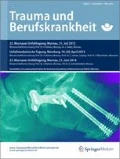Zusammenfassung
Obwohl Schuss- und Stichverletzungen in Deutschland selten sind, muss an Krankenhäusern jeglicher Versorgungsstufen die akute Erstversorgung entsprechend Verletzter – auch in größerer Anzahl, wie beispielsweise nach einem Amoklauf – gewährleistet sein. Wichtige Voraussetzungen für ein gutes Outcome sind ein prioritätenorientiertes standardisiertes präklinisches Management, ein standardisiertes Schockraummanagement sowie, falls erforderlich, die rasche, pragmatische erste operative Phase im Sinne von „damage control surgery“. Im vorliegenden Beitrag werden Maßnahmen für Präklinik, Schockraum und erste operative Phase nach penetrierenden Höhlenverletzungen an Thorax und Abdomen vorgestellt.
Abstract
Although gunshot and stab wounds are rare in Germany, hospitals must be capable of carrying out all levels of acute primary care of victims – also in large numbers, as for example in the case of a homicidal rampage. Important prerequisites of a good outcome include priority-based standardized preclinical management, standardized shock-room management and, where necessary, a prompt and practical initial surgical phase in the form of“damage control surgery”. The current article presents steps for preclinical, shock-room and initial surgical phases following penetrating cavity wounds to the chest and abdomen.

Literatur
Bickell WH, Wall MJ Jr, Pepe PE et al (1994) Immediate versus delayed fluid resuscitation for hypotensive patients with penetrating torso injuries. N Engl J Med 331(17):1105–1109
Biff WL, Kaups KL, Cothren CC et al (2009) Management of patient with anterior abdominal stab wounds: a Western Trauma Association multicenter trial. J Trauma 65:1294–1301
Boffard KD (2007) Manual of definitive surgical trauma care, 2nd edn. Arnold, London
Comitte on Trauma, American College of Surgeons (2008) ATLS student course manual, 8th edn. American College of Surgeons, Chicago
Degiannis E, Bonanno F, Titius W et al (2005) Behandlung von penetrierenden Verletzungen an Hals, Thorax und Extremitäten. Chirurg 76:945–958
Degiannis E, Loogna D, Doll D et al (2006) Penetrating cardiac injuries: recent experience in South Africa. World J Surg 30:1258–1264
Glapa M, Kourie JF, Doll D, Degiannis E (2007) Early management of gunshot injuries to the face in civilian practice. World J Surg 31:2104–2110
Halter G, Orend KH (2005) Gefäßverletzungen im Thorax, Abdomen und Becken. Chirurg 76:411–426
Hirschberg A, Mattox K (2006) Top Knife – Kunst und Handwerk der Traumachirurgie. Springer, Berlin
Kobbe P, Pape HC (2008) Penetrierende Verletzungen. Notfall Rettungsmed 11:141–151
Loogna P, Bonanno F, Bowley DM et al (2007) Emergency thoracic surgery for penetrating, non-mediastinal trauma. ANZ J Surg 77:142–145
National Association of Emergency Medical Technicians (NAEMT) (2007) PHTLS prehospital trauma life support, 6th edn. Mosby-Elsevier, St Louis
Stettbacher A, Doll D (2007) Die Notfallthorakothomie im Rahmen des Polytraumamanagements. Chirurg 78:474
Vastmans J, Däbritz SH (2004) Herzverletzungen. Trauma Berufskrankh 6:64–68
Woelfl CG, Wentzensen A, Zimmermann G (2007) Aktuelle Standards der Volumentherapie beim Traumapatienten. Trauma Berufskrankh 9:182–185
Woelfl CG, Bouillon B, Lackner CK et al (2008) Prehospital Trauma Life Support® (PHTLS®) – Ein interdisziplinäres Ausbildungskonzept für die präklinische Traumaversorgung. Unfallchirurg 111:688–695
Woelfl CG, Bouillon B, Lackner CR et al (2009) Was können wir von ATLS® – Advanced Trauma Life Support – lernen. In: Deutsche Akademie für Anästhesiologische Fortbildung (ed) Refresher Course – Aktuelles Wissen für Anästhesisten. Aktiv Druck, Ebelsbach, 35:180–188
Interessenkonflikt
Der korrespondierende Autor gibt an, dass kein Interessenkonflikt besteht.
Author information
Authors and Affiliations
Corresponding author
Rights and permissions
About this article
Cite this article
Wölfl, C., Vock, B., Wentzensen, A. et al. „Stop the bleeding!“ – „Damage control surgery“ vs. definitive Versorgung . Trauma Berufskrankh 11, 183–191 (2009). https://doi.org/10.1007/s10039-009-1503-4
Published:
Issue Date:
DOI: https://doi.org/10.1007/s10039-009-1503-4
Schlüsselwörter
- Schussverletzung
- Stichverletzung
- Standardisiertes präklinisches Management
- Standardisiertes Schockraummanagement
- „damage control surgery“

